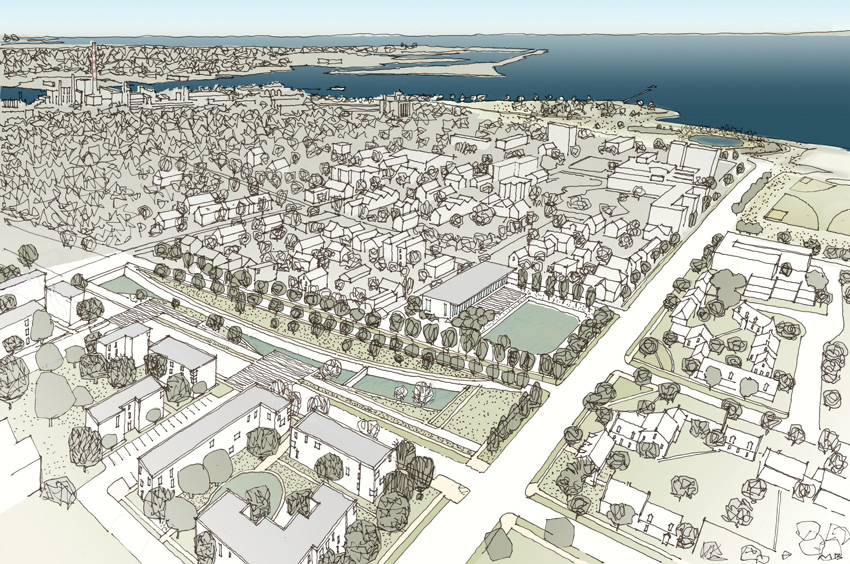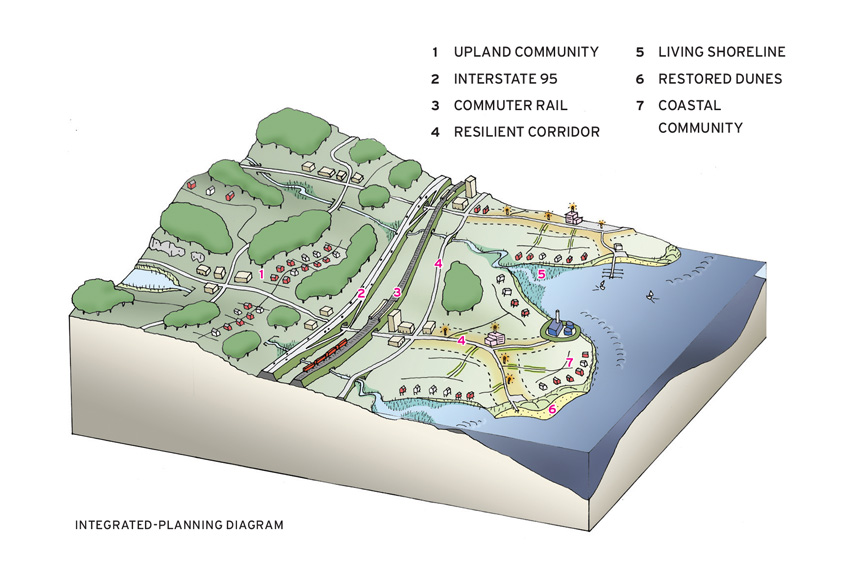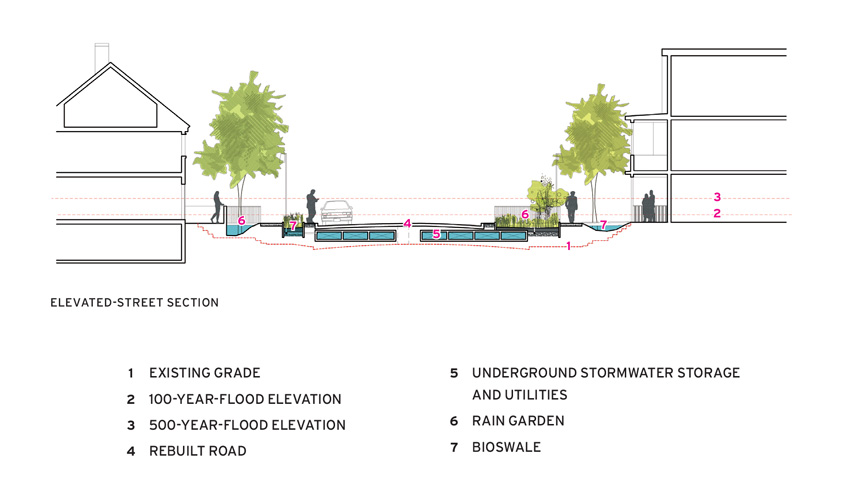Coastal Resilience
 1 AIA LU/HSW; 0.1 IACET CEU*; AAA 1 Structured Learning Hour; This course can be self-reported to the AANB, as per their CE Guidelines; AAPEI 1 Structured Learning Hour; This course can be self-reported to the AIBC, as per their CE Guidelines.; MAA 1 Structured Learning Hour; This course can be self-reported to the NLAA.; This course can be self-reported to the NSAA; NWTAA 1 Structured Learning Hour; OAA 1 Learning Hour; SAA 1 Hour of Core Learning
1 AIA LU/HSW; 0.1 IACET CEU*; AAA 1 Structured Learning Hour; This course can be self-reported to the AANB, as per their CE Guidelines; AAPEI 1 Structured Learning Hour; This course can be self-reported to the AIBC, as per their CE Guidelines.; MAA 1 Structured Learning Hour; This course can be self-reported to the NLAA.; This course can be self-reported to the NSAA; NWTAA 1 Structured Learning Hour; OAA 1 Learning Hour; SAA 1 Hour of Core Learning
Learning Objectives:
- List some of the strategies that are often referred to as “green” or “soft” infrastructure.
- Discuss how green infrastructure and traditional hard infrastructure can be combined to protect coastal cities from flooding, sea-level rise, and storm surge.
- Outline the resilience-strengthening measures planned for Lower Manhattan and Bridgeport, Connecticut.
- Discuss how cost-benefit analyses are calculated for infrastructure projects.
This course is part of the Resiliency Academy
With construction slated to start in 2019 and be completed by 2025, the design for the ESCR, for which almost $800 million in federal and city funds have been committed, is the most developed of the two phases. It will improve pedestrian connections across the multilane FDR Drive to the East River and Stuyvesant Cove Parks with broad and sinuous footbridges. The pair of narrow parks, which are wedged between the roadway and the water, will be rebuilt to include diverse social spaces and topographical variety, gradually stepping up in elevation as they move away from the water’s edge. According to Siegel, many of the parks’ features will emulate natural systems such as wetlands, barrier islands, and dunes, and protect the coastline by buffering waves and storm surges.
To mitigate flash flooding, the ESCR will also have plenty of porous and pervious surfaces as well as temporary stormwater storage. The team is also currently exploring options for retention basins, including recessing paved recreational areas, such as basketball courts. These could be designed to fill with water during heavy downpours and, once flooding subsides, they would be slowly drained, easing the burden on the city’s sewer system.
Sixty miles up the coast from Manhattan, a similar combination of hard and soft infrastructure strategies is planned for Bridgeport, Connecticut, which straddles the Pequannock River and lies exposed to the Long Island Sound on a set of peninsulas. The once-thriving industrial city was hard hit by Hurricane Irene in 2011, and then Sandy a year later.
“The tendency is to look only at the infrastructure, but the first thing to consider are the natural systems,” says David Waggonner, president of New Orleans–based Waggonner & Ball, which is leading the Rebuild by Design team known as Resilient Bridgeport. Tapping into Dutch flood-control expertise, the firm has developed an urban water plan for its home city, as well as other towns and regions.

IMAGE: © WAGGONNER & BALL
DELAY AND CONVEY
Plans for Bridgeport, Connecticut, include a new park with a water-retention pond. It will help slow stormwater runnoff, easing the burden on the city’s sewer system.
The Bridgeport team’s plan makes the most the city’s existing assets, including Seaside Park, designed by Fredrick Law Olmsted. Although the city sustained substantial flood damage from Sandy, this swath of green space along the coast helped buffer low-lying areas from the full intensity of the storm surge. The Resilient Bridgeport scheme takes advantage of this parkland, while weaving in new protective barriers in strategic places.
The new barriers, which will be combined with natural mitigation components, are in some instances berms and in others seawalls, and will sometimes be located near the water’s edge and at others pulled several blocks inland, leaving an area to cushion the storm surge.
These protections are one of four HUD-funded Resilient Bridgeport projects, all concentrated near the city’s South End, slated to begin construction in 2019. With a total budget of about $47 million, this first phase will also include raising some neighborhood streets, creation of a South End Stormwater Park, and construction of a Resilient Bridgeport Center that will serve as a community educational facility.
By raising some roadways, the project will provide a means of dry egress from low-lying areas. The elevated streets, which would be roughly at the first-floor level of the adjacent houses, will connect to their front stoops via small bridges. The space in between the houses and the new roadway could house rain gardens for slowing and absorbing runoff, while the space below the street surface could be used for box culverts and utilities. The new streets will connect to naturally occurring glacial ridges that run perpendicular to the water, forming a waffle-like network of resilient corridors. A similar plan is being implemented in other coastal cities such as Miami Beach, where key roadways are being raised to serve as protection and as routes where vehicular traffic can travel unimpeded during floods.
For dealing with heavy rainfall, which can overwhelm the city’s antiquated combined sewer system, Resilient Bridgeport relies on a “delay and convey” strategy similar to that proposed for Lower Manhattan. The approach emphasizes green infrastructure such as bioswales, green roofs, and temporary water storage to slow runoff. These tactics will be used in combination with gray infrastructure (pumps and pipes) and some raised streets in the 2½-acre Stormwater Park planned for a site adjacent to an affordable-housing development. The park will also include recessed play areas and green space that can temporarily store water during a heavy rainstorm. If these basins fill to a critical level, the water could be pumped to a nearby creek.
Another initiative of Resilient Bridgeport is to help ensure the continuity of electrical service after an extreme weather event, since the loss of power hampers recovery efforts and can have far-reaching safety, social, and economic impacts. The program addresses this challenge by promoting microgrids: local electrical networks that can operate independently of the traditional grid if a power outage occurs. Several such projects, relying on fuel cells, gas turbines, and heat-recovery loops, are in the predevelopment phase in the city, according to David Kooris, the state director of both Rebuild by Design and National Disaster Resilience, another HUD-funded program.


IMAGE: © ANDREW STERNAD, YALE URBAN ECOLOGY & DESIGN LAB (TOP); WAGGONNER & BALL (BOTTOM)
HIGH AND DRY
The Bridgeport scheme calls for raising some streets in the city’s South End (bottom). These would work in conjunction with naturally occuring glacial ridges (top) to create a network of resilient corridors.
Like most major infrastructure projects, the New York and Connecticut projects have undergone a cost-benefit analysis. There are a number of accepted methods for calculating this ratio, depending on the source of funding. While the Federal Emergency Management Agency’s considers only the hard cost of flood-mitigation measures and, in some cases, the cost of business interruption, HUD-funded projects such as the ESCR and Resilient Bridgeport can take a broader range of factors into account. “That agency allows you to count ecological and quality-of-life benefits. It’s a softer accounting method,” Waggoner explains. Both projects have favorable benefit-to-cost ratios, with the ESCR at 2.8:1 and the Bridgeport Stormwater Park at 1.6:1. Anything above 1:1 is considered cost-effective.
The analyses show that the benefits of projects like those planned for Lower Manhattan and Bridgeport far outweigh the risk of doing nothing. Though not yet built, they present a powerful argument against the Trump administration’s efforts to defund climate-change-related programs and roll back policies intended to protect flood-prone areas. Waggonner remains committed to improving the resilience of coastal cities. “It’s all about persistence,” he says, citing his own city: “A lesson from New Orleans is that the challenges keep changing, but you have to persevere, check your direction, see where you are, and move ahead.”
Michael Cockram is a freelance writer and director of Bowerbird Design in Fayetteville, Arkansas.










